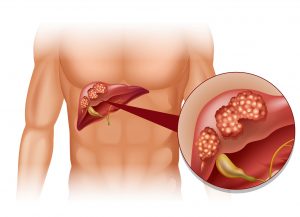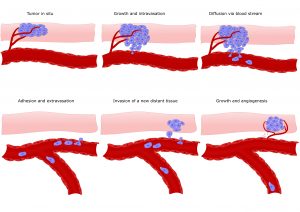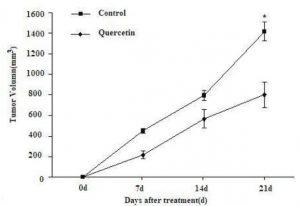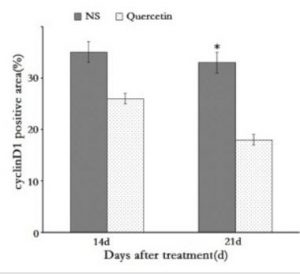Treating liver cancer with quercetin
 Liver cancer is the second most common cancer worldwide and according to the World Health Organization it caused 788,000 deaths in 2015. The leading cause of liver cancer is cirrhosis caused by either hepatitis B, hepatitis C, or alcohol.(1) Other causes are aflatoxin, non-alcoholic fatty liver disease and liver flukes.
Liver cancer is the second most common cancer worldwide and according to the World Health Organization it caused 788,000 deaths in 2015. The leading cause of liver cancer is cirrhosis caused by either hepatitis B, hepatitis C, or alcohol.(1) Other causes are aflatoxin, non-alcoholic fatty liver disease and liver flukes.
The most common types of liver cancer are hepatocellular carcinoma (HCC), which makes up around 80% of cases, and cholangiocarcinoma. Less common types of liver cancer include mucinous cystic neoplasm and intraductal papillary biliary neoplasm (2).
During its early stages liver cancer is often hard to detect but it grows rapidly and it has a high rate of metastasis. Metastasis is the spread of cancer cells to new areas of the body usually via the bloodstream or lymph system. A metastatic cancer, or metastatic tumor, is one which has spread from where it started to a different area or even areas of the body. Due to these factors the majority of liver cancer patients are not diagnosed until advanced stages which leads to poor patient outcomes.
The current standard of care is surgery, stereotactic radiation, chemotherapy and interventional embolization although these approaches are not ideal or always effective (3). Researchers are increasingly searching for more effective alternative methods for combating cancer and in the last few years quercetin has been in the spotlight for its potential to treat cancer.
Naturally occurring flavonoids including quercetin have been investigated for their potential to treat other types of cancer with a number of studies demonstrating its anticancer properties (4-6) as well as its ability to inhibit cell proliferation (7-8). Today we are going to have a look at a new research paper that explores the potential of quercetin to treat liver cancer via its interaction with cyclin D1(9).
Cyclin D1 is a subtype of cell protein cyclin D, its primary function is to maintain cell cycle and promote cell proliferation. It can bind with cyclin-dependent kinase (CDK4) and phosphorylate the inhibiting protein retinoblastoma (Rb).This binding can cause disassociation of Rb from E2F transcription factor and can lead to the alteration of the cell cycle and create excessive cell proliferation.
For this reason cyclin D1 is regarded as a proto-oncogene due to its effect on cell proliferation once it becomes dysfunctional. So far, several studies have demonstrated that high cyclin D1 expression is seen in cancers including breast, lung, prostate, lymph node and colorectal cancers [10–11]. This makes targeting cyclin D1 a potential therapeutic for cancer and therefore compounds able to target it of great interest to researchers.
Building on their previous experiment
The researchers had previously shown that quercetin was able to inhibit the proliferation of HepG2 (a human liver cancer cell line) cells and induce apoptosis, most likely they concluded via the participation of cyclin D1 regulation (12). However, their previous study had only been conducted in vitro and next the research team wanted to test quercetin in vivo in a murine model.
To demonstrate the anticancer effect of quercetin the research team created a subcutaneous tumour-bearing nude mouse model to monitor the effect of quercetin on tumor growth. The researchers opted to use the same HepG2 cell line that they had used for their previous experiment in order to see if the in vivo results translated to their in vitro testing.
The researchers reported that the mice in the control group displayed significantly higher tumor growth rate compared to mice treated with quercetin. The quercetin test group showed significantly lower tumor growth and tumor volume in comparison. The chart below shows the difference between the control and test groups.

The previous study showed that quercetin had a significant inhibitory effect on the cell cycle regulation gene cyclin D1 in vitro. In the new study the research team observed that quercetin also had a significant inhibitory effect on the growth of the tumors in the mice. They ran tests to compare cyclin D1 gene expression before and after treatment with quercetin and compared to the control group, cyclin D1 was significantly lower in the quercetin group as shown in the diagram below.

Conclusion
The researchers demonstrated that quercetin was able to significantly inhibit the proliferation of liver cancer cells as well as induce apoptosis and alter their cell cycle. It was also confirmed that quercetin was able to reduce cyclin D1 gene expression significantly in the liver cancer cells. Quercetin was able to delay tumor growth through its influence on cyclin D1 making its further study of great interest in combating liver and other types of cancer.
The ability of quercetin and other flavonoids are gaining increasing levels of interest from the research community for their potential to treat cancer and whilst more research studies are needed it is interesting all the same.
References
(1) Naghavi, M., Wang, H., Lozano, R., Davis, A., Liang, X., Zhou, M., … & Aziz, M. I. A. (2015). Global, regional, and national age-sex specific all-cause and cause-specific mortality for 240 causes of death, 1990-2013: a systematic analysis for the Global Burden of Disease Study 2013. Lancet, 385(9963), 117-171.
(2)Stewart, B. W. K. P., & Wild, C. P. (2014). World cancer report 2014.
(3)Jemal, A., Bray, F., Center, M. M., Ferlay, J., Ward, E., & Forman, D. (2011). Global cancer statistics. CA: a cancer journal for clinicians, 61(2), 69-90.
(4)Chan, S. T., Yang, N. C., Huang, C. S., Liao, J. W., & Yeh, S. L. (2013). Quercetin enhances the antitumor activity of trichostatin A through upregulation of p53 protein expression in vitro and in vivo. PLoS One, 8(1), e54255.
(5)Tao, S. F., He, H. F., & Chen, Q. (2015). Quercetin inhibits proliferation and invasion acts by up-regulating miR-146a in human breast cancer cells. Molecular and cellular biochemistry, 402(1-2), 93-100.
(6)Refolo, M. G., D’Alessandro, R., Malerba, N., Laezza, C., Bifulco, M., Messa, C., … & Tutino, V. (2015). Anti proliferative and pro apoptotic effects of flavonoid quercetin are mediated by CB1 receptor in human colon cancer cell lines. Journal of cellular physiology, 230(12), 2973-2980.
(7)Yuan, Z., Long, C., Junming, T., Qihuan, L., Youshun, Z., & Chan, Z. (2012). Quercetin-induced apoptosis of HL-60 cells by reducing PI3K/Akt. Molecular biology reports, 39(7), 7785-7793.
(8)Gibellini, L., Pinti, M., Nasi, M., Montagna, J. P., De Biasi, S., Roat, E., … & Cossarizza, A. (2011). Quercetin and cancer chemoprevention. Evidence-Based Complementary and Alternative Medicine, 2011.
(9)Zhou, J., Fang, L., Liao, J., Li, L., Yao, W., Xiong, Z., & Zhou, X. (2017). Investigation of the anti-cancer effect of quercetin on HepG2 cells in vivo. PloS one, 12(3), e0172838.
(10)Hwang, S. J., Lee, H. W., Kim, H. R., Song, H. J., Lee, D. H., Lee, H., … & Kim, H. H. (2015). Overexpression of microRNA-95-3p suppresses brain metastasis of lung adenocarcinoma through downregulation of cyclin D1. Oncotarget, 6(24), 20434.
(11)Kim, M. K., Park, G. H., Eo, H. J., Song, H. M., Lee, J. W., Kwon, M. J., … & Jeong, J. B. (2015). Tanshinone I induces cyclin D1 proteasomal degradation in an ERK1/2 dependent way in human colorectal cancer cells. Fitoterapia, 101, 162-168.
(12)Zhou, J., Li, L., Fang, L., Xie, H., Yao, W., Zhou, X., … & Luo, F. (2016). Quercetin reduces cyclin D1 activity and induces G1 phase arrest in HepG2 cells. Oncology Letters, 12(1), 516-522.